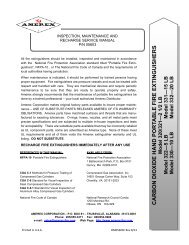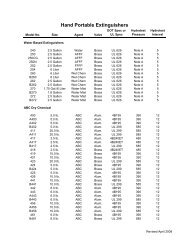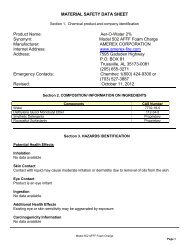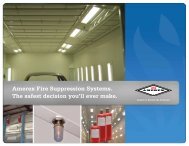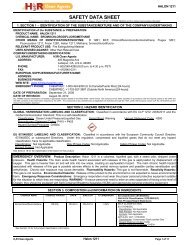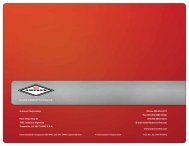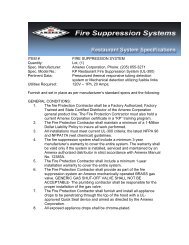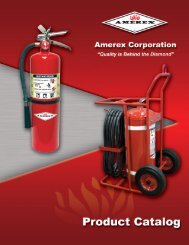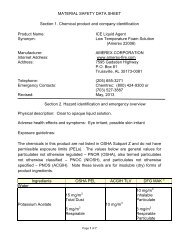Manual for 30 lb. hand portable Class D extinguishers.pdf - Amerex ...
Manual for 30 lb. hand portable Class D extinguishers.pdf - Amerex ...
Manual for 30 lb. hand portable Class D extinguishers.pdf - Amerex ...
You also want an ePaper? Increase the reach of your titles
YUMPU automatically turns print PDFs into web optimized ePapers that Google loves.
INSPECTION<br />
INSPECTION (NFPA-10) is a "quick check" intended to give reasonable assurance that an extinguisher<br />
is fully charged and operable. This is done by seeing that it is in its designated place, that it has not<br />
been actuated or tampered with, and that there is no obvious physical damage or condition to prevent<br />
operation.<br />
PERIODIC INSPECTION PROCEDURES<br />
(Monthly or more often if circumstances dictate)<br />
(NFPA-10) A "quick check" should be made of the extinguisher <strong>for</strong> the following:<br />
1. Located in designated place.<br />
2. No obstructions to access or visibility.<br />
3. Operating instructions on nameplate and facing outward.<br />
4. Seals and tamper indicators not broken or missing.<br />
5. Determine fullness by weighing or "hefting".<br />
6. Examine <strong>for</strong> obvious physical damage, corrosion, leakage or clogged nozzle.<br />
7. Pressure gauge reading in the operable area.<br />
MAINTENANCE<br />
MAINTENANCE (NFPA-10) Maintenance should be per<strong>for</strong>med at least once a year (or more<br />
frequently if indicated by an inspection). Maintenance is a "thorough check" of an extinguisher. It is<br />
intended to give maximum assurance that an extinguisher will operate effectively and safely. It includes<br />
a thorough examination and any necessary repair or replacement. It will normally reveal the need <strong>for</strong><br />
hydrostatic testing.<br />
MAINTENANCE PROCEDURE<br />
1. Clean extinguisher to remove dirt, grease or <strong>for</strong>eign material. Check to make sure that the<br />
instruction nameplate and FM manifest are securely fastened and legible. Inspect the cylinder<br />
<strong>for</strong> corrosion, abrasion, dents or weld damage. If any of these conditions are found and you<br />
doubt the integrity of the cylinder, hydrostatically test to factory test pressure (585 psi [4035<br />
kPa]), using the proof pressure method, in accordance with CGA Pamphlet C-6 and NFPA<br />
Pamphlet 10. See proper method of depressurizing and reclaiming chemical in "Recharge<br />
Procedures". NOTE: When cleaning avoid use of solvents around the pressure gauge. They<br />
could seriously damage the plastic gauge face.<br />
2. Inspect the extinguisher <strong>for</strong> damaged, missing or substitute parts. Only factory replacement<br />
parts are approved <strong>for</strong> use on <strong>Amerex</strong> fire <strong>extinguishers</strong>.<br />
3. Weigh extinguisher and compare with weight printed in the "Maintenance" section on the<br />
nameplate (label). Recharge extinguisher if weight is not within indicated allowable tolerances<br />
(see instructions in "Recharge Procedure").<br />
4. Check the date of manufacture stamped on the bottom of the extinguisher <strong>for</strong> model B570 and<br />
on the wall hanger loop <strong>for</strong> Model 570. Cylinder must be hydrostatically (proof pressure) tested<br />
every 12 years to the test pressure indicated on the nameplate (585 psi [4035 kPa]).<br />
4



